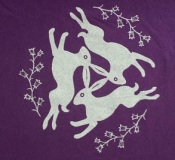Three Hares
SKU:
£17.85
£17.85
Unavailable
per item
The hare is regarded as a sacred animal in many cultures with associations with the moon, fertility and rebirth. The gestation period of the hare is 28 days which approximates to the full cycle of the moon and the menstrual cycle. There are examples of hare mythology within Chinese, Egyptian and Indian mythology.
During the Anglo-Saxon period Goddess Oestara or Eostre, with her associations with spring, was said to be accompanied by a sacred hare, although this may have simply been a fanciful guess by one of the Grimm brothers. There is a long association between witches and hares which seems to take two forms. The first is that a witch can transform herself into a hare and in that guise perform various deeds, whereas the second is the notion of a hare as a familiar which would act as her companion and accomplice. A hare crossing your path was therefore thought to be very bad luck.
There is a particular concentration of the symbol in the area around Dartmoor in England. A total of 28 examples have been identified in the area, many commissioned from the wealth generated by tin mining, and the symbol is often referred to as the Tinners Hares.
If you take a closer look you will notice that each hare shares an ear with its neighbour. So the symbol is a clever piece of rotational symmetry with the depiction of only three ears for a total of three hares.
There is an extraordinary Middle- English ritual poem titled the Names of the Hare and intended to be recited by a hunter on encountering the mammal for the first time. It includes 77 names for the hare included in its' glorious inventory, which includes such marvels as "dew flirt", "the starer", "stubble stag", "hedge squatter" and the "faith breaker." You can hear the poem performed by clicking on the link at the bottom.
Because of its folkloric associations there are many songs featuring the hare. One of the most frequently recorded in various guises is Hares on the Mountain (Roud 329), but most versions seem to contain the memorable lines:
"If all you young men were hares on the mountain,
How many young girls would take guns and go hunting?"
Further reading
Evans, George Ewart (1972) The Leaping Hare. London. Faber and Faber.
During the Anglo-Saxon period Goddess Oestara or Eostre, with her associations with spring, was said to be accompanied by a sacred hare, although this may have simply been a fanciful guess by one of the Grimm brothers. There is a long association between witches and hares which seems to take two forms. The first is that a witch can transform herself into a hare and in that guise perform various deeds, whereas the second is the notion of a hare as a familiar which would act as her companion and accomplice. A hare crossing your path was therefore thought to be very bad luck.
There is a particular concentration of the symbol in the area around Dartmoor in England. A total of 28 examples have been identified in the area, many commissioned from the wealth generated by tin mining, and the symbol is often referred to as the Tinners Hares.
If you take a closer look you will notice that each hare shares an ear with its neighbour. So the symbol is a clever piece of rotational symmetry with the depiction of only three ears for a total of three hares.
There is an extraordinary Middle- English ritual poem titled the Names of the Hare and intended to be recited by a hunter on encountering the mammal for the first time. It includes 77 names for the hare included in its' glorious inventory, which includes such marvels as "dew flirt", "the starer", "stubble stag", "hedge squatter" and the "faith breaker." You can hear the poem performed by clicking on the link at the bottom.
Because of its folkloric associations there are many songs featuring the hare. One of the most frequently recorded in various guises is Hares on the Mountain (Roud 329), but most versions seem to contain the memorable lines:
"If all you young men were hares on the mountain,
How many young girls would take guns and go hunting?"
Further reading
Evans, George Ewart (1972) The Leaping Hare. London. Faber and Faber.




